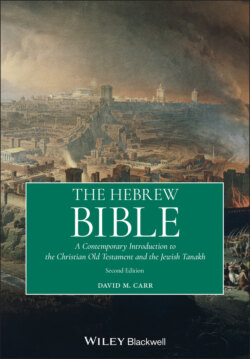Читать книгу The Hebrew Bible - David M. Carr - Страница 15
Оглавление
Timeline
| Important texts are noted in boldface. | ||
| BCE | SOUTH (Judah) | NORTH (“Israel” in narrower sense) |
| 1300 | (Waning Egyptian domination of Canaan) | Spread of villages in Israelite hill county |
| Merneptah Stela mention of “Israel” | ||
| 1200 | Battles of hill‐country Israelites with neighbors | |
| Oral exodus traditions | ||
| Oral ancestral traditions | ||
| 1100 | Oral victory traditions | |
| Saul’s “chieftainship” David (Hebron; 1010–1002) | ||
| 1000 | David (Jerusalem; 1002–970) | |
| Royal psalms, Zion psalms | ||
| Solomon (Jerusalem; 970–930) | ||
| Proverb collections (early form??) Non‐P primeval narrative | ||
| Rehoboam (Jerusalem) | Jeroboam founds northern monarchy | |
| 900 | (early form of written) Jacob narrative, Joseph novella, and exodus‐Moses narrative | |
| Song of Deborah (written form) | ||
| Omride dynasty (880–841) | ||
| Jehu’s coup (841) | ||
| 800 | Jeroboam II (782–753)Amos | |
| Isaiah (early prophecy) Assyrian domination of Israel begins (745–) | ||
| Syro‐Ephraimite war (735–734) | Hosea | |
| Assyrian domination of Judah (734–) | ||
| Micah, Isaiah (later prophecy) | ||
| Assyrian destruction of Israel (722) | ||
| Hezekiah (715–686) | ||
| Hezekiah’s rebellion and reform (705) | ||
| 700 | Sennacherib’s attack and mysterious withdrawal (701) | |
| Manasseh (686–642) | ||
| Amon (642–640) | (Waning of Assyrian power) | |
| Josiah (640–609) | ||
| Zephaniah | ||
| Josiah’s reform (623) | ||
| Josianic edition of Deuteronomy, 2 Kings, etc. | ||
| (Fall of Nineveh, Assyria’s capital) | ||
| Nahum | ||
| Jeremiah | ||
| Domination of Judah by Babylonia | ||
| 600 | First wave of exiles (597) | |
| Ezekiel’s early prophecy | ||
| Destruction of Jerusalem and second wave of exiles (586) | ||
| Lamentations and Psalm 137 | ||
| Ezekiel’s later prophecy | ||
| Third wave of exiles (582) | ||
| Exilic additions to Deuteronomy, 2 Kings, and other Books | ||
| Non‐P/L Pentateuchal source (incorporating exilic‐modified forms of older non‐P primeval history, Jacob‐Joseph story, exodus‐Moses story, and Deuteronomy) | ||
| Priestly Pentateuchal source | ||
| Second Isaiah | ||
| Persian conquering of Babylonian empire (539) | ||
| First wave of returnees (~538) | ||
| Another wave, beginning of Temple restoration (532) | ||
| Another wave with Zerubbabel, completion of Temple rebuilding (520–515) | ||
| Haggai and Zechariah (1–9) | ||
| 500 | Nehemiah’s return and governorships (445–425)(rebuilding wall, purification of priesthood) | |
| Nehemiah memoir | ||
| 400 | Return with Ezra, divorce of foreign wives, elevation of Torah (397–) | |
| Combined (P and non‐P/L) Pentateuch | ||
| Narratives of Temple‐rebuilding and Ezra | ||
| Third Isaiah | ||
| Psalter (final, Torah‐oriented version of the book) | ||
| Greek conquering of Persian empire (332) | ||
| 300 | (Shifting domination of Palestine by Greek Ptolemies (Egypt) and Seleucids (Mesopotamia); 332–142) | |
| Early parts of Enoch | ||
| 1–2 Chronicles | ||
| Wisdom of Ben Sira (Sirach) | ||
| 200 | Jason purchase of high priesthood, attempt to Hellenize Jerusalem (174) | |
| Menelaus purchase of high priesthood (171) and Judean rebellion against him | ||
| Daniel | ||
| Antiochus Epiphanes IV campaign to eradicate observant Judaism and beginning of Hasmonean‐led rebellion against Hellenistic rule (167–) | ||
| Purification and rededication of Temple (164) | ||
| Hasmonean independence and rule (142–63) | ||
| Ezra‐Nehemiah, Esther | ||
| 1–2 Maccabees, Judith | ||
| 100 | ||
| CE | Roman takeover of Palestine (63) | |
| Destruction of the Second Temple (70) |
MAP 0.1 The ancient Near East.
Redrawn from Adrian Curtis (ed.), Oxford Bible Atlas (4th edition). Oxford, New York: Oxford University Press, 2007, page 67.
